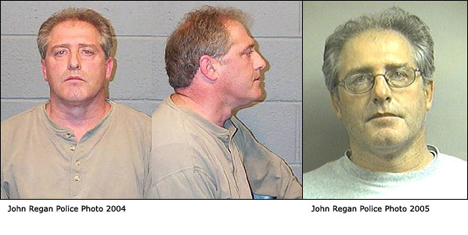To Catch A Monster
Excellent Work By The Waterbury Police Department Leads To Arrest In Controversial 1993 Rape Case
Story by John Murray

At the end of another long day at police headquarters, Neil O’Leary climbed into his car and headed home. For the past 15 months, O’Leary had served as the acting chief of the Waterbury Police Department. As he headed home on that September night two months ago, O’Leary, 46, had a lot on his mind. The city had begun testing 11 candidates for the permanent chief’s job, and O’Leary was stressed about taking the oral and written exams.
While many insiders assumed O’Leary was a shoo-in to get the job, he knew better. He had to score in the top five candidates to move into the interview phase with Mayor Michael Jarjura, where he would be the prohibitive favorite to get the job. But he had to pass the test.
His 25 year career at the Waterbury Police Department was at a crossroad, if he passed the test he was confident he would be the next police chief. If he didn’t pass the test, he planned to retire. Apprehensive, and an admitted lousy test taker, O’Leary purchased several books to help prepare for the exams.
As he headed home to hit the books that night, something gnawed at O’Leary about an incident down at headquarters earlier that day. A 21-year-old girl had filed a complaint against a 47-year-old co-worker, alleging that he had tried to assault her in July. The case had caught O’Leary’s attention because the alleged assailant, John Regan, was from a prominent Waterbury family that O’Leary personally knew.
“I was thinking about the incident and then it hit me like a bolt of lighting,” O’Leary said. “I wondered if John Regan might be a suspect in an unsolved 1993 rape case.”
O’Leary was painfully familiar with the 11-year-old investigation into one of the most bizarre and embarrassing cases in Waterbury Police Department history. A prominent white businesswoman, Donna Palomba, was raped in her Overlook home in the early morning of September 11, 1993. The police botched the evidence at the scene and later accused Palomba of manufacturing the rape to cover-up an affair while her husband, John, was out of town.

Waterbury Police Chief Neil O’Leary
Within weeks of the attack the detective in charge of the case, Lt. Doug Moran, read Palomba her Miranda Rights, threatened to arrest her, and said she would lose custody of her two children if she didn’t confess to fabricating the rape. Palomba was devastated at the bizarre turn of events. Experts later testified at a civil trial that she suffered extreme psychological trauma and damage from the police. Donna Palomba had turned to the Waterbury Police Department for help, but the investigators didn’t believe her story. Appalled at the police investigation, State’s Attorney John Connelly reassigned the case to O’Leary, who at the time was second in command of the Waterbury detective bureau. O’Leary was stunned by what he encountered.
“This case has always bothered me because I have always felt the Waterbury Police Department let Donna Palomba down,” O’Leary said. “The case was mishandled from the beginning and we made huge mistakes in the investigation. The police never called out the forensic team that night and the cops, accusing her of having an affair, had not one piece of evidence to support their theory. How could we treat someone like that?”
O’Leary’s investigation took an immediate 180-degree turn. He quickly established that Palomba’s claim was completely credible – he believed she was raped and he set out to solve the case. The key fact in the case was that the rape occurred the first time John Palomba had been away from his family in 12 years. Whoever raped her, O’Leary believed, knew Donna, and knew that John wasn’t home. The investigation zeroed in on a stag party that was held the night the victim was raped. It was a stag party John Palomba would have attended, but he was in Colorado at a wedding. Many of his friends and family were at the stag party and it was widely known that John was out of town. O’Leary believed the rapist had attended the stag party.
“It was too coincidental that the first time John wasn’t home in 12 years, Donna was raped,” O’Leary said. “The rapist knew he wasn’t in the house. No one was going in that house if John Palomba was there.”
The one good thing the Waterbury Police Department did on the night of the rape was to send Donna Palomba to the hospital where evidence was collected off her body. O’Leary had the Palomba’s compile a list of people who knew Donna would be home alone that night, and DNA samples were taken from 36 individuals. Everyone on the list cooperated, but there was no DNA match.

Palomba eventually filed a civil lawsuit against the Waterbury Police Department for the mistreatment she received, and in 2001 won $190,000 in damages. One of the key witnesses in the trial was Neil O’Leary, who testified that Palomba had been mistreated during the initial investigation. O’Leary testified that he found Donna’s story credible and could not understand how anyone listening to her 911 call would question if she had been raped.
During the trial the Republican-American newspaper further victimized Palomba, known in their articles as Jane Doe, with insensitive and slanted coverage that fanned the rumor mill about a fabricated rape, an affair, and questionable charges against the Waterbury Police Department. Anyone reading the coverage in the Republican-American which was decidedly pro-police was left questioning the victim’s credibility.
Despite the negative press directed at Jane Doe, Palomba realized many people in Waterbury knew her identity and may still believe she had fabricated the rape to cover up an affair. After winning the trial, Palomba approached the Waterbury Observer in an effort to set the record straight. During a two-month span she met with the Observer for nearly 12 hours of interviews and shared hundreds of pages of court transcripts and police documents. The Observer published her story, Survivor in a 10,000-word, 11-page spread, in April 2001.
The Break
After wondering if John Regan might be a suspect in Palomba’s rape case, Neil O’Leary called an old friend who knew John Regan and John Palomba. O’Leary wanted to know if there was any chance that John Regan was at the stag party that night.
Sure, the friend told O’Leary, the stag party was for John Regan’s cousin. He would definitely have been there.
And, O’Leary found out, John Regan knew both Donna and John Palomba. They were friends. O’Leary felt sick to his stomach, but made arrangements to meet with the Palombas to talk. Over the years O’Leary continued to meet with the couple to plumb for any new leads that might break the case. As they talked, O’Leary said he casually asked whether they knew John Regan. Not only did they know him, they said, John Regan had been inside their home. O’Leary mentioned that Regan had been accused of assaulting a young co-worker, and had been at the stag party 11 years ago. O’Leary told John and Donna that Regan was going to be arrested for allegedly assaulting the 21 year old.
During the arrest O’Leary asked if Regan would give a DNA sample, and Regan agreed. The DNA turned out to be a perfect match with the DNA recovered from Donna Palomba on the night of the rape.
“I was shocked and stunned,” O’Leary said. “The result hit me like a ton of bricks. I felt terrible for both families because they all knew each other.”
Because the statute of limitations on sexual assault charges ran out six years ago, Regan was arrested and charged with kidnapping. Regan pleaded not guilty at his arraignment and is now free on a $350,000 bond. Regan has hired prominent defense attorney Hubie Santos to defend him. A pre-trial hearing is set for November 17th and it is unknown at this time whether Santos will try to cut a plea bargain deal for Regan, or take the case to trial. Meanwhile, Regan has a full restraining order on him to stay away from the Palombas.
The Republican-American newspaper reported Regan’s arrest in the local section on October 23. Unlike the slanted and twisted reports that were published three years ago, this time, a different reporter, Cara Rubinsky, wrote a fair and balanced account of the case.
“I’m very grateful that the paper got it right this time.” Donna Palomba said.
And Neil O’Leary is grateful as well. He has been a Waterbury police officer for 25 years and said Donna’s case had deeply troubled him for 11 years. “This one stuck with me,” he said. “There is great relief at finding the perpetrator for the victim, and for the citizens of Waterbury. We never gave up and I believe we have solved the crime. DNA is the same as a fingerprint. Hopefully, this can build more public confidence in the Waterbury Police Department.”
Donna
There are many negative things that transpired since a masked intruder broke into Donna Palomba’s home 11 years ago and raped her. She prefers to focus on the positives.
“I am so grateful to Neil O’Leary for never giving up on my case,” Palomba said. “It would have been easy for him to forget this cold case, but he kept at it. It was incredible police work that broke the case. Persistence does pay off.”
There are certain people that never doubted Palomba. Detective George Lescardes of the Waterbury Police Department, like O’Leary, stuck his neck out and testified against the other officers. John “Pudgy” Maia, an investigator in the state attorney’s office, reached out to Donna and John and offered to help in any way he could. In 1988 Maia hand delivered a letter from Donna to Dr. Henry Lee, an internationally renowned forensic expert, that triggered a re-sampling of the physical evidence using new DNA technology. The results were then entered into state and national databases. Dr. Lee also testified at the civil trial in early 2001 that the Waterbury police had mishandled the crime scene.
Donna has experienced enormous relief knowing that a suspect had been arrested and a perfect DNA match established in the case. “This takes the wonder out of it,” she said. “Time passes and I’ve tried to heal. You wonder who did it, but I don’t have to wonder anymore.”
There is relief and vindication for Donna, but the fact that John Regan is charged with the crime is mind-bending. “The violation is compounded by the betrayal of friendship.
DNA is more powerful than denial. Our system states that you are innocent until proven guilty,” Palomba said. “DNA doesn’t lie; it is proof. It’ a perfect match.”
O’Leary said the police are still investigating anyone with information regarding the case, and the Waterbury Police Department has requested that the state police lab examine DNA samples taken from other unsolved sexual assault cases. Sexual assault is the most under-reported major crime and O’Leary said the way Palomba’s case was initially handled is a perfect example why.
“She stepped forward to report a crime and the investigators didn’t believe her,” O’Leary said. “This case brought to light deficiencies we had in the police department.”
And those deficiencies were addressed by Palomba’s civil suit against the police department in 2001. She wasn’t after money to line her pockets, she said, she wanted to bring about change inside the Waterbury Police Department, and with O’Leary’s help, and Lt. Dave Janetty’s help, policy did change.
Sexual assault investigations have been taken away from the vice and intelligence division and are now handled by the detective bureau. The police department has formed a sexual assault squad with women in charge of interviewing the victims. And O’Leary said the police now have a policy that any victim, especially sexual assault victims, will not have their story challenged unless the police have factual proof to back up their questioning.
“There is nothing more devastating than to think the police don’t believe you,” O’Leary said. “And in this case we had no evidence to question her story. There was not one piece of evidence to support the theory that she had made this up. None. The victim has been fully vindicated.”
Palomba has battled for 11 years to make sense of the attack, and is grateful that she was able to turn something so evil, into something good.
“I was innocent. I did nothing but tell the truth,” she said. “And now no woman will ever go into the Waterbury Police Department and be treated that way again. They will be treated with dignity and respect. Helping to change policy inside the police department has been a catalyst in my healing. It is much safer to come forward now; the entire culture of the department has changed.”
And in time, Palomba is hopeful that the stigma of sexual assault can change as well. With the blessing of her husband and children, Palomba plans on launching the Jane Doe No More Foundation to tackle the issue.
In the end, this story is about perseverance and hope. By putting her faith in God, Palomba transformed the most negative experience in her life into a positive. She fought for change and got it. She never gave up hope that the rapist would be caught, and eleven years after the brutal attack, it appears that the Waterbury Police Department has solved the case.
And as it turns out, the best police work sometimes happens at the most unexpected times. Neil O’Leary was driving home, completely stressed out about passing written and oral exams, and a random thought fluttered into his head. And in that moment, he connected the dots between two cases separated by an eleven-year span, and in the process vindicated both Donna Palomba and the Waterbury Police Department.
Finally, Neil O’Leary did pass his exams and was sworn in as police chief, November 3rd, during a festive ceremony at the newly renovated Palace Theater in downtown Waterbury.
